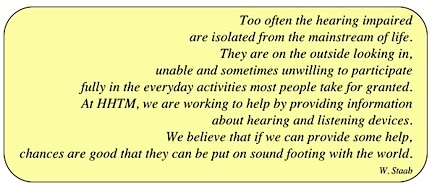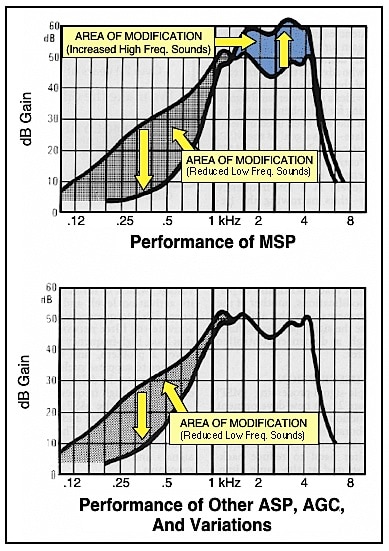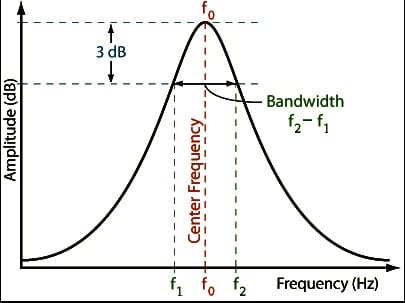A Case for Mid-frequency Amplification (Continued)
 Should mid-frequencies be given more than a cursory consideration when it comes to fitting hearing aids? Last week’s post reviewed some acoustic characteristics of speech and their significance in speech perception. These included long-known information related to speech spectra; the relationship between speech power, frequency, and intelligibility; critical bands; crossover frequency; and formants as important energy bands – all showing that mid-frequencies contribute significantly to speech perception.
Should mid-frequencies be given more than a cursory consideration when it comes to fitting hearing aids? Last week’s post reviewed some acoustic characteristics of speech and their significance in speech perception. These included long-known information related to speech spectra; the relationship between speech power, frequency, and intelligibility; critical bands; crossover frequency; and formants as important energy bands – all showing that mid-frequencies contribute significantly to speech perception.
This post continues in this direction, again by reviewing data that has stood the test of time to see what kind of mid-frequency features could be helpful for a successful hearing aid fitting. This post focuses on the relationship of intelligibility and bandwidth. Keep in mind that when it comes to amplification systems, hearing aids are considered as narrow band (we prefer the terminology “controlled fidelity”) rather than as high-fidelity systems.
Justifications for High-frequency Emphasis
Justifications for providing amplification in the high frequencies are provided in training of hearing professionals as follows: (1) Most hearing losses result in poor high-frequency hearing sensitivity, and, as such, the hearing aid should be able to provide amplification for sounds not heard, and (2) Most speech sounds necessary for understanding of speech (consonants) have their energy regions in the high frequencies. Therefore, this frequency region should be compensated for (amplified) when affected by a hearing loss. It is difficult to argue against these justifications, and hearing aid fittings tend to reflect on this “fitting the audiogram” approach.
However, as discussed in last week’s post, and now in this post, mid frequencies also warrant in-depth consideration. In solving hearing problems, it is seldom that we have the luxury of being able to concentrate on a single feature alone. In fact, just about any speech perception feature can be found to be significant when evaluated solely. However, when multiple communication features are combined, the vision is clouded dramatically, and the single feature significance may no longer hold prominence.
Intelligibility vs. Bandwidth
Figure 1 shows generalized equal articulation (intelligibility) contours plotted for a bandpass system having a center frequency of 1500 Hz{{1}}[[1]]Egan JP, Wiener FM: On the intelligibility of bands of speech in noise. J Acoust Soc Am 1946; 18:435-441[[1]]. It shows that as the bandwidth is decreased (made narrower), the intensity must be increased to maintain the discrimination-score constant. This generalized family of equal-articulation contours was constructed with a center frequency of 1500 Hz, but shifting the entire family of curves horizontally can make a reasonable approximation to other center frequencies.

Figure 1. Generalized equal-word recognition contours plotted for band-pass systems centered at 1500 Hz. In this graphic, the widest bandwidth has 60% word recognition of a wide band system (100 to 10,000 Hz); the next band, being narrower, having just 40% word recognition of a wide band system, etc. As bandwidth is narrowed, intensity must be increased to equate the word recognition score of 60%. For hearing aids, this suggests that wider bandwidth requires less gain.
Figure 1 implies that the wider the frequency response range of the hearing aid, the less gain will be required. This would be somewhat analogous to comparing wide-band against narrow-band noise that is used in masking during audiometric testing. In the past, this was also readily demonstrated by hearing aid wearers fitted with hearing aids with user-controlled volume control. Hearing aid wearers would advance the volume control as low-frequency filtering occurred (AGC systems operating in noise). If the hearing aid fitting focuses on high-frequency-emphasis (narrow band by definition), the gain requirement must be very high – so high that it is likely to cause undue acoustic feedback problems. Unfortunately, the irony is that in avoiding feedback in this example results in effectively reducing high-frequency amplification with some variation of a feedback control/reduction circuit.
This relationship between intelligibility and bandwidth is identified also by Licklider and Miller{{2}}[[2]] Licklider JCR, Miller GA: The perception of speech. Handbook of Experimental Psychology. New York, John Wiley & Sons, Inc., 1951, pp. 1040-1074[[2]] when they state “The contribution of a given band of frequencies depends upon the intensity of the speech in the band, as well as upon the width of the band.” They go on to say that less (quieter) amplification is required to reach a satisfactory listening comfort level with a wider bandwidth. This allows a hearing aid user to be able to listen in louder environments at a lower level, which means that the hearing aid can delay its activation of any noise-reduction circuitry and to increases hearing aid headroom as well, making loud sounds less distorted. Cox, makes a similar comment related specifically to hearing aid use, suggesting that the optimal gain at any frequency depends partly on hearing aid bandwidth{{3}}[[3]] Cox, RM, Gilmore C: Damping the hearing aid frequency response: Effects on speech clarity and preferred listening level. J Speech Hear Res 1986; 29:357-365[[3]].
Hearing Aid Fitting Attempts to Incorporate Bandwidth and Intelligibility

Figure 2. Multiple Signal Processor hearing aid from Audiotone. This was a first commercial hearing aid to attempt to compensate for reduced gain when the hearing aid frequency response narrowed (due to reduced low frequency amplification initiated by the AGC circuitry in this example). When the amplification bandwidth narrowed, increased gain was provided in the high frequencies.
An early commercial hearing aid attempt to control for increased gain when the bandwidth was narrowed was a design by Audiotone (Figure 2){{4}}[[4]] Staab WJ, Nunley J: New development: Multiple signal processor (MSP). Hear J 1987; 40(8): 24-26[[4]]. This instrument (called a Multiple Signal Processor) was designed to automatically provide greater high-frequency gain as the bandwidth was narrowed due to the low-frequency suppression produced by the hearing aid’s input-AGC action. It integrated specific psychoacoustic principles in its design and acted as a frequency suppressor and as a frequency expander.
Wider Bandwidths
That wider bandwidth results in improved speech intelligibility in quiet and in noise was reported by various authors dating back to 1983{{5}}[[5]] Skinner, M.W. and Miller, J.D. Amplification, bandwidth and intelligibility of speech in quiet and noise for listeners with sensorineural hearing loss, International Journal of Audiology, 1983, Vol. 22, No. 3, pages 253-279[[5]], with continued confirmation{{6}}[[6]] Beck DL, Olsen J. Extended bandwidths in hearing aids. Hearing Review. 2008; 15(11): 22-26[[6]]{{7}}[[7]] Grasso, C., Quaglia, D., Farinetti, L, Fiorio, G., De Martin, J. Wide-band compensation of presbycusis, From Proceeding (404). Signal Processing, Pattern Recognition, and Applications, 2003[[7]], even though the bandwidth was only extended from 4000 Hz to 6000 and 8000 Hz. For the past several years, at least one hearing aid manufacturer has an instrument approximating an upper frequency response to 16,000 Hz.
A somewhat different approach to bandwidth and intelligibility was the use of extended low-frequency amplification along with upward extension of the frequency band (widening the bandwidth), to improve speech intelligibility{{8}}[[8]]Sung RJ, Sung GS: Low frequency amplification and speech intelligibility in noise. Hear lnstr 1982. 33(1): 20,47[[8]]. The authors suggested that a hearing aid with combined low-frequency amplification and extended high-frequency response beyond 6000 Hz provided listeners with maximum speech intelligibility in noise. In the early transition to digital, most hearing aids had no significant amplification beyond 4000 Hz, and even today, many hearing aids do not provide extended amplification beyond 6000 Hz. This makes confirmation of the extended high-frequency response beyond 6000 Hz somewhat difficult.
Additionally, amplification of the frequency range into the low frequencies seems to be critical for better sound quality. This was certainly a factor during the emergence of in-the-canal (ITC) hearing aids. Small speakers designed for these instruments resulted in fabrication advantages, but consumers complained about the high-frequency “tinny” sound quality produced by the smaller speakers. Most manufacturers quickly returned to the slightly larger speaker that provided greater low-frequency amplification, and reduced consumer complaints. Lybarger reported in 1978{{9}}[[9]]Lybarger, S. Expanding the usefulness of adjustable vent inserts, Hear Instr 1978; 29:18-19[[9]] that a vent in an earmold of about 2 mm actually produced a low-frequency enhancement of 5 to 9 dB around 500 to 600 Hz. It seemed ironic that venting (under certain conditions) could actually provide some amplification in the low frequencies when venting was intended to reduce low-frequency amplification. It was believed that this vent resonance salvaged many hearing aid fittings by providing a slight gain increase in the low frequencies, and at the same time, providing for sound quality improvement.
A limited number of studies have been conducted that have attempted to determine any relationship between speech intelligibility and increased bandwidth. Stelmachowicz, et. al.{{10}}[[10]] Stelmachowicz PG, Pittman AL, Hoover M, Lewis DE: Effect of stimulus bandwidth on the perception of /s/ in normal- and hearing-impaired children and adults. J Acoust Soc Am 2001; 110:2183-2190[[10]] tested both adults and children having a wide range of hearing losses, and found a trend toward improvement in speech intelligibility for high-frequency phoneme perception, but not statistically significant. In another study in which children were fitted binaurally with wideband amplification and compression, the author stated that it was likely that a combination of factors, including bandwidth, contributed to the significantly higher benefit over their own hearing aids{{11}}[[11]]Lindley, G. Children seen to gain extra benefit from greater bandwidth, binaural compression, The Hearing Journal, Vol. 62, No. 10, pp 28-31, 2009[[11]].
Results of an investigation of perception of filtered speech (low-pass, high-pass, and band-pass) by hearing impaired listeners showed that for all subjects, intelligibility of the materials used remained relatively high, whether they were high-pass filtered at 700 Hz or low-pass filtered at 2800 Hz, when heard with sufficient intensity{{12}}[[12]] Milner P, Braida LD, Durlach NI, Levitt H: Perception of filtered speech by hearing-impaired listeners. ASHA Reports Number 14, Speech Recognition by the Hearing Impaired. Rockville, MD, Speech-Language-Hearing Association, October 1984, pp. 3047[[12]]. More specifically, when listeners with sloping sensorineural hearing losses were evaluated, the following occurred: removing the high-frequency energy from 2800 Hz up to the 4500 Hz cutoff had little effect on reducing intelligibility. A more significant effect resulted from removing the energy below 700 Hz. However, at sufficiently high presentation levels, intelligibility was equal to or exceeded that achieved for the unfiltered condition (which included spectral components below 700 Hz).






